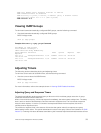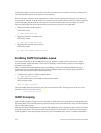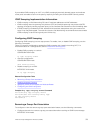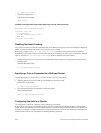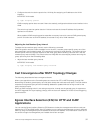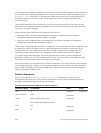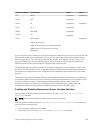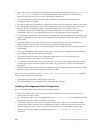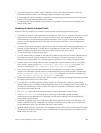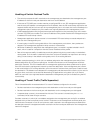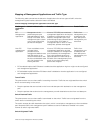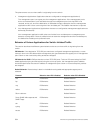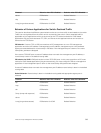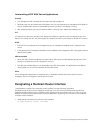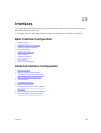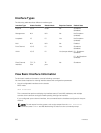• In the netstat output, the prefix “mgmt” is added to routes in the EIS table so that the user can
distinguish between routes in the EIS Routing table and default routing table.
• If the management port IP address is removed, the corresponding connected route is removed from
both the EIS routing table and default routing table.
• If a management route is deleted, then the route is removed from both the EIS routing table and
default routing table.
Handling of Switch-Initiated Traffic
When the control processor (CP) initiates a control packet, the following processing occurs:
• TCP/UDP port number is extracted from the sockaddr structure in the in_selectsrc call which is called
as part of the connect system call or in the ip_output function. If the destination TCP/UDP port
number belongs to a configured management application, then sin_port of destination sockaddr
structure is set to Management EIS ID 2 so that route lookup can be done in the management EIS
routing table.
• To ensure that protocol separation is done only for switch initiated traffic where the application acts
as client, only the destination TCP/UDP port is compared and not the source TCP/UDP port. The
source TCP/UDP port becomes a known port number when the box acts as server.
• TFTP is an exception to the preceding logic.
• For TFTP, data transfer is initiated on port 69, but the data transfer ports are chosen independently by
the sender and receiver during initialization of the connection. The ports are chosen at random
according to the parameters of the networking stack, typically from the range of temporary ports.
• If route lookup in EIS routing table succeeds, the application-specific packet count is incremented.
This counter is viewed using the show management application pkt-cntr command. This
counter is cleared using clear management application pkt-cntr command.
• If the route lookup in the EIS routing table fails or if management port is down, then packets are
dropped. The application-specific count of the dropped packets is incremented and is viewed using
the show management application pkt-drop-cntr command. This counter is cleared using
clear management application pkt-drop-cntr command.
• Packets whose destination TCP/UDP port does not match a configured management application, take
the regular route lookup flow in the IP stack.
• In the ARP layer, for all ARP packets received through the management interface, a double route
lookup is done, one in the default routing table and another in the management EIS routing table. This
is because in the ARP layer, we do not have TCP/UDP port information to decide the table in which
the route lookup should be done.
• The show arp command is enhanced to show the routing table type for the ARP entry.
• For the clear arp-cache command, upon receiving the ARP delete request, the route
corresponding to the destination IP is identified. The ARP entries learned in the management EIS
routing table are also cleared.
• Therefore, a separate control over clearing the ARP entries learned via routes in the EIS table is not
present. If the ARP entry for a destination is cleared in the default routing table, then if an ARP entry
for the destination exists in the EIS table, that entry is also cleared.
• Because fallback support is removed, if the management port is down or the route lookup in EIS table
fails packets are dropped. Therefore, switch-initiated traffic sessions that used to work previously via
fallback may not work now.
Internet Group Management Protocol (IGMP)
381



